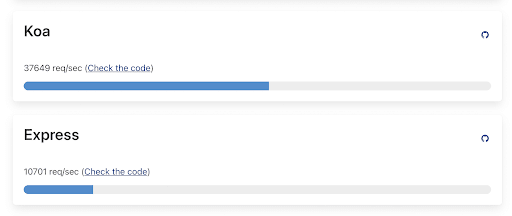Express or Koa?
Most developers using Node.js are using frameworks to improve productivity, scalability, and speed of application development, facilitate quick prototyping, and automate processes with the help of libraries, templates, and reusable components.
Two of the most popular frameworks are Express and Koa.
Express is a widely used and flexible Node.js web application framework that provides a robust set of features for web and mobile applications. It is quick and easy to create a robust API with many HTTP utility methods and middleware available.
Koa is a new web framework designed by the team behind Express, which aims to be a smaller, more expressive, and a more robust foundation for web applications and APIs. By leveraging async functions, Koa allows you to ditch callbacks and significantly improve the experience of error handling. Koa does not bundle any middleware within its core, and it provides an elegant suite of methods that make writing servers fast and enjoyable for developers.
Even though Express has been called the de facto standard server framework for Node.js and it's the most popular one with 18 million weekly downloads, Koa is rapidly growing in popularity with 1.2 million weekly downloads because it's lightweight, has great user experience and superior performance (37K req/sec vs. 10K req/sec of Express).
Why Use Serverless?
Serverless is a cloud execution model that enables a more straightforward, cost-effective way to build and operate cloud-native applications. The application owner does not purchase, rent, manage, or provision the servers in this cloud architecture. Instead, the cloud provider manages the infrastructure side of things for the applications.
Despite the name, serverless apps do not run without servers 😂. It means that businesses don't need to manage the server-side of the equation and operational concerns, and instead focus on development.
The most significant advantage of this architecture is that the provisioning of servers is done dynamically to meet the real-time computing demand. That is, you pay only for what you use. The same could be said about running monolithic applications on VMs behind an Auto Scaling Group, which was available for years before serverless. The key change in serverless is also the change in the scope of the unit of deployment, from a monolithic app to a single function.
Click here to learn how to run Express.js and Koa.js on AWS Lambda.




Top comments (1)
Thanks, short and concise.
But what's your opinion on NestJS? Have you tried it?